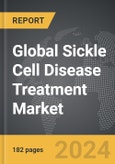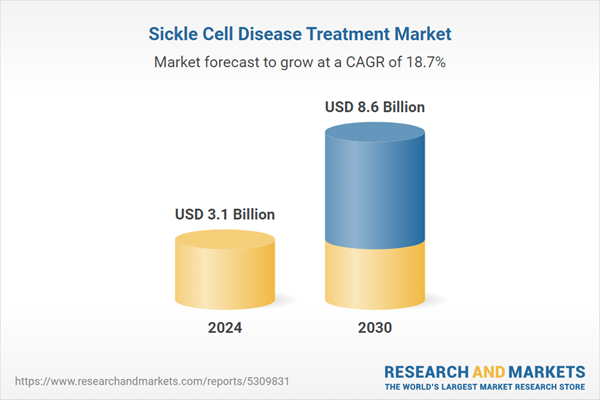The global market for Sickle Cell Disease Treatment was valued at US$3.1 Billion in 2024 and is projected to reach US$8.6 Billion by 2030, growing at a CAGR of 18.7% from 2024 to 2030. This comprehensive report provides an in-depth analysis of market trends, drivers, and forecasts, helping you make informed business decisions. The report includes the most recent global tariff developments and how they impact the Sickle Cell Disease Treatment market.
Segments: Treatment Type (Blood Transfusion, Bone Marrow Transplant, Pharmacotherapy).
Geographic Regions/Countries: World; United States; Canada; Japan; China; Europe (France; Germany; Italy; United Kingdom; and Rest of Europe); Asia-Pacific; Rest of World.
The analysts continuously track trade developments worldwide, drawing insights from leading global economists and over 200 industry and policy institutions, including think tanks, trade organizations, and national economic advisory bodies. This intelligence is integrated into forecasting models to provide timely, data-driven analysis of emerging risks and opportunities.
Global Sickle Cell Disease Treatment Market - Key Trends and Drivers Summarized
Why Is Sickle Cell Disease Treatment Gaining Global Attention?
Sickle cell disease (SCD) treatment is gaining significant global attention due to its rising prevalence and the severe impact it has on the quality of life of patients. Sickle cell disease is a hereditary blood disorder characterized by abnormally shaped red blood cells, which can cause severe pain, frequent infections, and other life-threatening complications. Predominantly affecting people of African, Mediterranean, South Asian, and Middle Eastern descent, SCD is becoming a major public health concern, especially in regions like Sub-Saharan Africa, where the disease burden is particularly high. Efforts to improve early diagnosis, increase awareness, and develop comprehensive care frameworks are driving the demand for effective treatment solutions, including pain management, hydroxyurea therapy, blood transfusions, and bone marrow transplants.How Are Technological Advancements Revolutionizing Sickle Cell Disease Treatment?
Technological advancements are revolutionizing sickle cell disease treatment by introducing innovative therapies such as gene therapy and CRISPR-based genome editing. These advanced treatments aim to provide a one-time cure by correcting the defective gene responsible for the disease, unlike conventional therapies that primarily focus on symptom management. Several gene therapies, including Lentiglobin, are currently under clinical trials, showing promise in reversing the effects of SCD and reducing the need for regular blood transfusions and pain management. The advent of personalized medicine, which involves tailoring treatment plans based on the genetic makeup of the individual, is further enhancing the effectiveness of these therapies. In addition to gene therapy, other novel approaches such as voxelotor and L-glutamine therapies are expanding the range of available treatment options, providing relief from symptoms and improving patient outcomes.Which Market Segments Are Leading the Adoption of Sickle Cell Disease Treatment?
Treatment types include pharmacotherapy, blood transfusion, bone marrow transplant, and gene therapy, with pharmacotherapy being the most widely adopted due to its accessibility and affordability. However, gene therapy is expected to grow at the fastest rate due to its potential as a curative treatment. End-users of SCD treatments include hospitals, specialty clinics, and research organizations, with hospitals being the primary adopters due to their role in providing comprehensive care and managing complications associated with the disease. Geographically, North America and Europe are the leading markets for SCD treatment due to advanced healthcare infrastructures, ongoing clinical trials, and regulatory support for orphan drug development. Meanwhile, Africa and the Middle East are emerging as key markets due to the high prevalence of SCD and increasing government initiatives for improved healthcare access.What Are the Key Drivers of Growth in the Sickle Cell Disease Treatment Market?
The growth in the sickle cell disease treatment market is driven by several factors, including the rising prevalence of sickle cell disease globally, advancements in gene therapy and CRISPR technology, and increasing investment in R&D for targeted therapies and biological drugs. The development of curative therapies, novel drug combinations, and cell-based therapies is driving market adoption among hospitals, specialty clinics, and research organizations. The focus on enhancing early diagnosis, personalized medicine, and patient-centric care models is expanding the market reach among pediatric and adult patients. The growing use of telemedicine and digital health platforms for SCD management, coupled with the demand for affordable and accessible treatment solutions, is creating new opportunities for market growth. Additionally, the increasing collaboration between research institutions, pharmaceutical companies, and non-profit organizations for developing innovative treatments is further supporting market expansion.Report Scope
The report analyzes the Sickle Cell Disease Treatment market, presented in terms of units. The analysis covers the key segments and geographic regions outlined below.Segments: Treatment Type (Blood Transfusion, Bone Marrow Transplant, Pharmacotherapy).
Geographic Regions/Countries: World; United States; Canada; Japan; China; Europe (France; Germany; Italy; United Kingdom; and Rest of Europe); Asia-Pacific; Rest of World.
Key Insights:
- Market Growth: Understand the significant growth trajectory of the Blood Transfusion segment, which is expected to reach US$6.5 Billion by 2030 with a CAGR of a 19.3%. The Bone Marrow Transplant segment is also set to grow at 17.5% CAGR over the analysis period.
- Regional Analysis: Gain insights into the U.S. market, valued at $846.3 Million in 2024, and China, forecasted to grow at an impressive 17.3% CAGR to reach $1.3 Billion by 2030. Discover growth trends in other key regions, including Japan, Canada, Germany, and the Asia-Pacific.
Why You Should Buy This Report:
- Detailed Market Analysis: Access a thorough analysis of the Global Sickle Cell Disease Treatment Market, covering all major geographic regions and market segments.
- Competitive Insights: Get an overview of the competitive landscape, including the market presence of major players across different geographies.
- Future Trends and Drivers: Understand the key trends and drivers shaping the future of the Global Sickle Cell Disease Treatment Market.
- Actionable Insights: Benefit from actionable insights that can help you identify new revenue opportunities and make strategic business decisions.
Key Questions Answered:
- How is the Global Sickle Cell Disease Treatment Market expected to evolve by 2030?
- What are the main drivers and restraints affecting the market?
- Which market segments will grow the most over the forecast period?
- How will market shares for different regions and segments change by 2030?
- Who are the leading players in the market, and what are their prospects?
Report Features:
- Comprehensive Market Data: Independent analysis of annual sales and market forecasts in US$ Million from 2024 to 2030.
- In-Depth Regional Analysis: Detailed insights into key markets, including the U.S., China, Japan, Canada, Europe, Asia-Pacific, Latin America, Middle East, and Africa.
- Company Profiles: Coverage of players such as Acceleron Pharma, Inc., Alnylam Pharmaceuticals, Inc., Arena Pharmaceuticals, Inc., AstraZeneca PLC, Baxter International, Inc. and more.
- Complimentary Updates: Receive free report updates for one year to keep you informed of the latest market developments.
Some of the 13 companies featured in this Sickle Cell Disease Treatment market report include:
- Acceleron Pharma, Inc.
- Alnylam Pharmaceuticals, Inc.
- Arena Pharmaceuticals, Inc.
- AstraZeneca PLC
- Baxter International, Inc.
- bluebird bio, Inc.
- Bristol-Myers Squibb Company
- Eli Lilly and Company
- Emmaus Life Sciences, Inc.
- Global Blood Therapeutics, Inc.
- Novartis AG
- Pfizer, Inc.
- Sangamo Therapeutics, Inc.
Tariff Impact Analysis: Key Insights for 2025
Global tariff negotiations across 180+ countries are reshaping supply chains, costs, and competitiveness. This report reflects the latest developments as of April 2025 and incorporates forward-looking insights into the market outlook.The analysts continuously track trade developments worldwide, drawing insights from leading global economists and over 200 industry and policy institutions, including think tanks, trade organizations, and national economic advisory bodies. This intelligence is integrated into forecasting models to provide timely, data-driven analysis of emerging risks and opportunities.
What’s Included in This Edition:
- Tariff-adjusted market forecasts by region and segment
- Analysis of cost and supply chain implications by sourcing and trade exposure
- Strategic insights into geographic shifts
Buyers receive a free July 2025 update with:
- Finalized tariff impacts and new trade agreement effects
- Updated projections reflecting global sourcing and cost shifts
- Expanded country-specific coverage across the industry
Table of Contents
I. METHODOLOGYII. EXECUTIVE SUMMARY2. FOCUS ON SELECT PLAYERSIII. MARKET ANALYSISIV. COMPETITION
1. MARKET OVERVIEW
3. MARKET TRENDS & DRIVERS
4. GLOBAL MARKET PERSPECTIVE
UNITED STATES
CANADA
JAPAN
CHINA
EUROPE
FRANCE
GERMANY
ITALY
UNITED KINGDOM
REST OF EUROPE
ASIA-PACIFIC
REST OF WORLD
Companies Mentioned (Partial List)
A selection of companies mentioned in this report includes, but is not limited to:
- Acceleron Pharma, Inc.
- Alnylam Pharmaceuticals, Inc.
- Arena Pharmaceuticals, Inc.
- AstraZeneca PLC
- Baxter International, Inc.
- bluebird bio, Inc.
- Bristol-Myers Squibb Company
- Eli Lilly and Company
- Emmaus Life Sciences, Inc.
- Global Blood Therapeutics, Inc.
- Novartis AG
- Pfizer, Inc.
- Sangamo Therapeutics, Inc.
Table Information
| Report Attribute | Details |
|---|---|
| No. of Pages | 182 |
| Published | April 2025 |
| Forecast Period | 2024 - 2030 |
| Estimated Market Value ( USD | $ 3.1 Billion |
| Forecasted Market Value ( USD | $ 8.6 Billion |
| Compound Annual Growth Rate | 18.7% |
| Regions Covered | Global |









